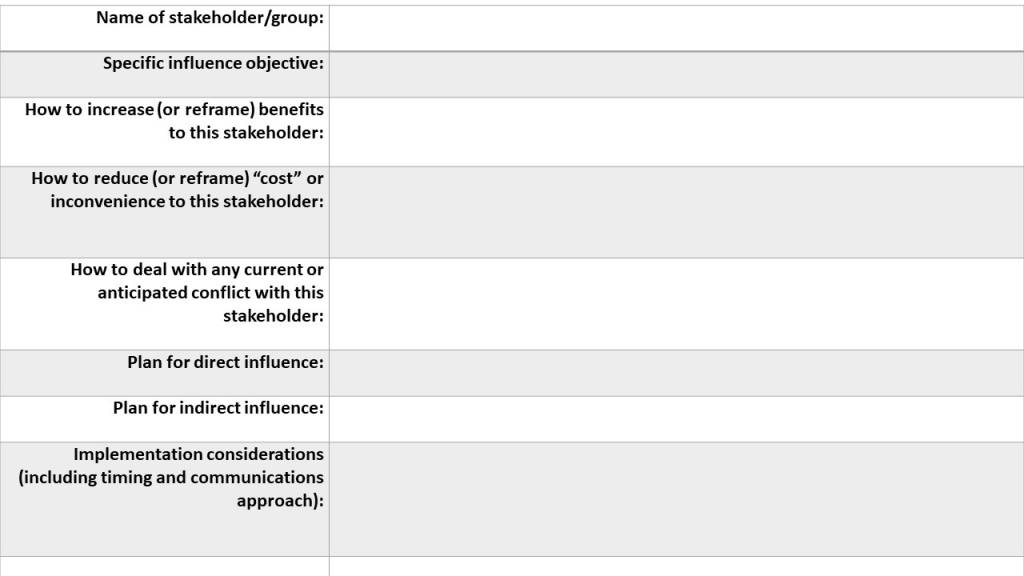
Project Stakeholder Plan
Having a project stakeholder plan ensures that you will approach the influence part of your project with as much organization and attention as possible. Time invested early in stakeholder planning can save you countless hours of dealing with resistance, redoing work, missing targets, etc.
WHAT TO DO:
- Use the worksheet Project Stakeholder Planning to create a plan for your identified key stakeholders.
- Implement the plan, monitor progress, and update information regularly.
EXPLANATION OF WORKSHEET ITEMS
- Influence objective: Describe in detail exactly what you want the person to do and describe what will happen when you successfully influence them.
- How to increase benefits to stakeholders: Identify anything you – or someone else with whom you have influence – can do to ensure that this person benefits from the project outcomes or activities. Think of how you might change that person’s perception if you perceive a benefit they do not. If the person already sees an advantage, consider how you can reinforce that impression.
- How to reduce cost or inconvenience to stakeholders: Identify anything you – or someone else with whom you have influence – can do to minimize the adverse effects of this project on this person. Think of how you can reframe the person’s perception if they perceive a cost/inconvenience, but you do not believe it will happen.
- How to deal with conflict with stakeholders: Write down your thoughts about a good approach to resolving conflict, given what you know about your own and this person’s conflict styles. If the conflict is disruptive team behavior, think of the steps you might take to deal with it, and consider whether you could reduce the conflict by addressing the team procedures, roles, and goals.
- Plan for direct influence: Identify your primary backup influence strategies. Think of how you should communicate with this person during your influence attempts.
- Plan for indirect influence: If you are not the best person to do this, think about whom you could ask to contact or attempt to influence this person in your place. Perhaps one of the supporters you identified earlier? Consider whether you have access to materials, information, meetings, industry peers, etc. that might make the person sympathetic to your project. If your stakeholder is a department or group, try to identify a friend or contact in that group who might serve as an informal link.
- Implementation Considerations: Identify the steps you will take and whether anything else has to happen first. Determine what method of communication (face-to-face, phone, email) you could use and should use.
WORKSHEET:
Project Stakeholder Planning

Key Principles
The more broadly you think about what constitutes your universe of stakeholders, the better your plan will be. Thinking broadly allows you to minimize the chance of being blindsided by resistance from a “missed” stakeholder.
Perception is what counts; stakeholders may perceive that they will be negatively affected by a project even when this is not the case. Moreover, when considering what may be necessary to people, put yourself in their position and do not trivialize their concerns. (we think people are “overreacting” whenever they react more than we would!)
You do not always have to influence people directly. The decision between a direct and indirect approach will depend on such elements as your position in the organization, the timing, your history with the person you are trying to influence, and other alternatives you may have.
If it seems too daunting to do this for all your essential stakeholders, start with one person and see what happens.

